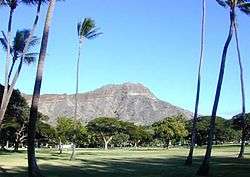Kapiolani Park

Queen Kapiʻolani Regional Park is the largest and oldest public park in Hawaiʻi, located in Honolulu, Hawaiʻi on the east end of Waikīkī just beyond Kuhio Beach Park and the Waikiki residential neighborhood. The 300-acre (1.2 km2) park, named after Queen Kapiʻolani, the queen consort of King David Kalākaua, is home to the Waikiki Shell and the Honolulu Zoo.
History
Prior to being used as a public space, the area was a mix of swamp land and arid plain unsuitable for building. In the 1870s, Kalākaua was charged to find a permanent, dry course for horse racing. Since Waikiki was popular with wealthy racing fans, Kalākaua chose the unoccupied and dry plain at the foot of Diamond Head where the park now stands. On June 11, 1877, the park was dedicated as the first Hawaiian public space. Scotsman Archibald Scott Cleghorn was Vice-president and later president of the Kapiʻolani Park Association, a group of businessmen, who convinced Kalākaua to give them a 30-year lease for $1 per year. Cleghorn was a Hawaiian citizen married into Hawaiian Royalty. Cleghorn planned the park's landscaping, including the majestic ironwood trees. Money was raised with $50 shares in the association. Shareholders could lease a beachfront lot near the park, and many had cottages there by the 1880s. A lease was granted to the Honolulu Cricket Club in 1893. Top cricket players from San Francisco's California Cricket Association played for local teams.[1] During the 1893 overthrow of the Kingdom of Hawaii, most of these became privately owned, and most were later given back to the city or condemned. Now the park consists of open green space, lilyponds, the Honolulu Zoo and the Waikiki Shell entertainment venue.[2]
After the overthrow, the land was conveyed to the Republic of Hawaii and managed by the Honolulu Park Commission. The legislation provided that the park be set aside permanently as a free public park and recreation ground, forbade the sale or lease of land in the park, and prohibited charging of any entrance fees. Since 1913, the park has been maintained by the City and County of Honolulu's Department of Parks & Recreation.[3]
Besides the zoo and the Shell, the park includes tennis and basketball courts, soccer, baseball, lacrosse and rugby fields and an archery range. The park hosts many international lacrosse and rugby tournaments a year.[4][5] Its bandstand serves as an entertainment venue. It is also a popular course for joggers who utilize its two-mile (3 km) circumference. The park also serves as the site, as both the starting and finish lines, of road races in Honolulu including the Honolulu Marathon.
Kapiʻolani park is also home to Honolulu Cricket Club, the only cricket club in the Hawaiian Islands. Founded in 1893, it is the oldest sporting club in the Pacific according to Guinness World Records.[6]
As Kapiʻolani Park continues south it becomes Kapiʻolani Beach Park, adjacent to Kuhio Beach and Waikiki Beach. The park itself also serves as a natural border between Waikiki and Diamond Head neighborhood. it is located at coordinates 21°16′9″N 157°49′8″W / 21.26917°N 157.81889°WCoordinates: 21°16′9″N 157°49′8″W / 21.26917°N 157.81889°W.
-
Kapiolani Beach Park
-

An 1881 ad announcing a horse race at the Kapiolani Park
-
One of the many Kapiolani Park Banyan Trees
References
- ↑ David Sentance, Cricket in America 1710-2000-research in progress for second edition
- ↑ Burl Burlingame (August 11, 2000). "Growth spurt". Honolulu Star-Bulletin. Retrieved June 8, 2010.
- ↑ Wyeneth, Robert (2002). "Brief park history". Kapiolani Park: a history. Kapiolani Park Preservation Society. Retrieved 2008-01-28.
- ↑ Hawaii Lacrosse - Official Page
- ↑ Hawaii State Rugby Union
- ↑ Julia Steele, photos by Sergio Goes. "Cricket, Anyone?". Hana Hou! Vol. 11, No. 1 (February/March 2008).